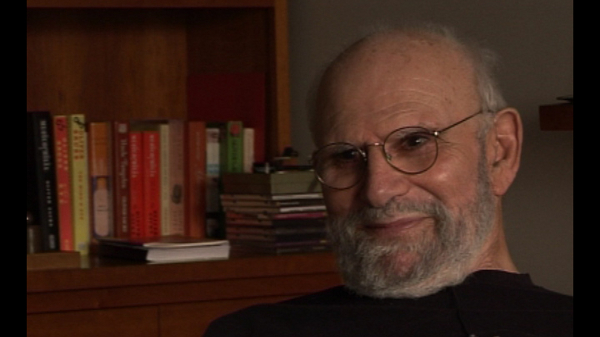NEXT STORY

The publication of Stereo Sue
RELATED STORIES

NEXT STORY

The publication of Stereo Sue
RELATED STORIES


|
Views | Duration | |
|---|---|---|---|
| 301. My love of scientific exploration books | 1 | 186 | 02:43 |
| 302. Anything better than Star Trek? | 1 | 238 | 00:21 |
| 303. Quoting 'Childhood's End' in 'Musicophilia' | 1 | 146 | 02:31 |
| 304. Stories associated with chemical elements | 178 | 03:04 | |
| 305. Which direction to take after 'Uncle Tungsten' and 'Oaxaca... | 127 | 00:47 | |
| 306. The case of Lilian Kallir: musical alexia | 598 | 03:35 | |
| 307. An aphasia case: Patricia | 1 | 670 | 03:38 |
| 308. How I first met 'Stereo Sue' | 182 | 04:54 | |
| 309. 'Stereo Sue' acquires stereoscopic vision at the age of 50 | 252 | 03:56 | |
| 310. The publication of Stereo Sue | 131 | 01:06 |


She said she had acquired stereovision, to her own astonishment, in her... in her 50th year, and it was the most wonderful enlargement, and heightening of vision. She found the world almost intolerably beautiful, and enriched by this. The only analogy she could think of, she said, perhaps someone who had never seen colour, and then was suddenly given colour, and how much richer the world would be for them. But she also said she was very surprised, because it was her understanding, and the understanding of her doctors, and of the profession generally that stereovision had to be acquired by the age of two, or thereabouts, or it could never be acquired. One would be past the critical period, but her own experience had been contrary to this. Well, I was fascinated by the letter, and I turned to my visual team, to Ralph Siegel, and Bob Wasserman, who had been with me on other visual adventures, and we drove up to Massachusetts, where Sue was, and we saw her.
I was a little bit suspicious, I have to say, I’d never heard of such a thing, I wondered if she was deluding herself. And I had brought along with me some special stereograms, containing print at different stereo levels, but one could only judge this if one had stereo. But anyhow, it was quite clear that Sue did have stereo, although she herself called it shallow stereo. There was one interesting thing. I brought along some of these red and green glasses, as well, so that all of us could look at some of the red and green anaglyphs, as they’re called, and there was one anaglyph of a geometrical figure, and Sue looked at it and she said, 'That’s where the apex is'. And for her the apex was about four centimetres, an inch and a half above the surface. For Ralph and for Bob it was six or seven centimetres above the surface, and for me it was 12 centimetres above the surface. And I was very, very surprised at this, because I thought, you know, by simple trigonometry almost, a given disparity would be interpreted as... as a given amount of depth, of stereo depth.
This actually confirmed my feeling, which I had had since boyhood, and which I shared with my fellow members of the New York Stereoscopic Society, since stereoscopy had been a lifelong passion for me, that I tended to see the world in exceptional depth. That I was very strongly, and... and perhaps too exclusively attuned to stereo clues, but there’s no doubt that Sue had developed this, and, well, there is a long story. She sent me her visual diary, and I wrote a long article about her, an article which was actually, partly autobiographic, because I relived my own passion for stereoscopy, and... so that too was published. So then I had had long articles on Lilian Kallir, the musician, on Aphasic Pat, and now on Stereo Sue.
Oliver Sacks (1933-2015) was born in England. Having obtained his medical degree at Oxford University, he moved to the USA. There he worked as a consultant neurologist at Beth Abraham Hospital where in 1966, he encountered a group of survivors of the global sleepy sickness of 1916-1927. Sacks treated these patients with the then-experimental drug L-Dopa producing astounding results which he described in his book Awakenings. Further cases of neurological disorders were described by Sacks with exceptional sympathy in another major book entitled The Man Who Mistook His Wife For A Hat which became an instant best seller on its publication in 1985. His other books drew on his rich experiences as a neurologist gleaned over almost five decades of professional practice. Sacks's work was recognized by prestigious institutions which awarded him numerous honours and prizes. These included the Lewis Thomas Prize given by Rockefeller University, which recognizes the scientist as poet. He was an honorary fellow of both the American Academy of Arts and Letters and the American Academy of Arts and Sciences, and held honorary degrees from many universities, including Oxford, the Karolinska Institute, Georgetown, Bard, Gallaudet, Tufts, and the Catholic University of Peru.
Title: 'Stereo Sue' acquires stereoscopic vision at the age of 50
Listeners: Kate Edgar
Kate Edgar, previously Managing Editor at the Summit Books division of Simon and Schuster, began working with Oliver Sacks in 1983. She has served as editor and researcher on all of his books, and has been closely involved with various films and adaptations based on his work. As friend, assistant, and collaborator, she has accompanied Dr Sacks on many adventures around the world, clinical and otherwise.
Tags: Massachusetts, New York Stereoscopic Society, Lilian Kallir, Stereo Sue, Susan R Barry, Bob Wasserman, Ralph Siegel
Duration: 3 minutes, 56 seconds
Date story recorded: September 2011
Date story went live: 02 October 2012